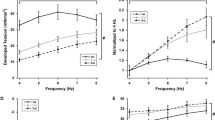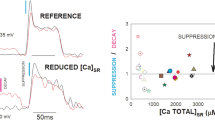Abstract
In chronic heart failure, skeletal muscles develop a weakness that is not associated to an impaired circulatory function but rather to alterations in the skeletal muscle fibers themselves. To understand these changes, the steps in excitation–contraction coupling of rats that underwent a left anterior coronary artery occlusion were studied. About 24 weeks after the myocardial infarction, neither the total amount nor the voltage dependence of intramembrane charge were altered. In contrast, calcium release from the sarcoplasmic reticulum was considerably suppressed, and its voltage dependence shifted toward more positive voltages. Elementary calcium-release events showed altered morphology as the relative proportion of embers increased. Calcium sparks were smaller in amplitude and had larger time-to-peak values. Isolated ryanodine receptors (RyR) displayed an unusual rectification with increased single-channel conductance at positive (cis vs trans) voltages. In addition, the bell-shaped calcium dependence of channel activity was broader, with a slight shift of activation to lower and a larger shift in inactivation to higher calcium concentrations. These data indicate that the number of channels that open during a calcium-release event is decreased and that RyR function is altered; thus, calcium-release is suppressed after a myocardial infarction. These observations give an explanation for the impaired skeletal muscle function in these animals.







Similar content being viewed by others
References
Carter S, Colyer J, Sitsapesan R (2006) Maximum phosphorylation of the cardiac ryanodine receptor at serine-2809 by protein kinase a produces unique modifications to channel gating and conductance not observed at lower levels of phosphorylation. Circ Res 98:1506–1513
Cheng H, Song LS, Shirokova N, Gonzalez A, Lakatta EG, Rios E, Stern MD (1999) Amplitude distribution of calcium sparks in confocal images: theory and studies with an automatic detection method. Biophys J 76:606–617
Clark AL, Poole-Wilson PA, Coats A (1996) Exercise limitation in chronic heart failure: central role of the periphery. J Am Coll Cardiol 28:1092–1102
Coats AJ (1996) The “muscle hypothesis” of chronic heart failure. J Mol Cell Cardiol 28:2255–2262
Cohn JN, Johnson GR, Shabetai R, Loeb H, Tristani F, Rector T, Smith R, Fletcher R (1993) Ejection fraction, peak exercise oxygen consumption, cardiothoracic ratio, ventricular arrhythmias, and plasma norepinephrine as determinants of prognosis in heart failure. The V-HeFT VA Cooperative Studies Group. Circulation 87:VI5–V16
Csernoch L, Pizarro G, Uribe I, Rodriguez M, Rios E (1991) Interfering with calcium release suppresses I gamma, the “hump” component of intramembranous charge movement in skeletal muscle. J Gen Physiol 97:845–884
Csernoch L, Szentesi P, Sarkozi S, Szegedi Cs, Jona I, Kovacs L (1999) Effects of tetracaine on sarcoplasmic calcium release in mammalian skeletal muscle fibres. J Physiol 515:843–857
Delbono O, Chu A (1995) Ca2+ release channels in rat denervated skeletal muscle. Exp Physiol 80:561–574
De Sousa E, Veksler V, Bigard X, Mateo P, Ventura-Clapier R (2000) Heart failure affects mitochondrial but not myofibrillar intrinsic properties of skeletal muscle. Circulation 102:1847–1853
Fabiato A (1988) Computer programs for calculating total from specified free or free from specified total ionic concentrations in aqueous solutions containing multiple metals and ligands. Methods Enzymol 157:378–417
Hollingworth S, Peet J, Chandler WK, Baylor SM (2001) Calcium sparks in intact skeletal muscle fibers of the frog. J Gen Physiol 118:653–678
Jondeau G, Katz SD, Zohman L, Goldberger M, McCarthy M, Bourdarias J-P, LeJemtel TH (1992) Active skeletal muscle mass and cardiopulmonary reserve. Failure to attain peak aerobic capacity during maximal bicycle exercise in patients with severe congestive heart failure. Circulation 86:1351–1356
Kirsch WG, Uttenweiler D, Fink RHA (2001) Spark- and ember-like elementary Ca2+ release events in skinned fibers of adult mammalian skeletal muscle. J Physiol 537:379–389
Klein MG, Lacampagne A, Schneider MF (1997) Voltage dependence of the pattern and frequency of discrete Ca2+ release events after brief repriming in frog skeletal muscle. Proc Natl Acad Sci USA 94:11061–11066
Kovács L, Rios E, Schneider MF (1983) Measurement and modification of free calcium transients in frog skeletal muscle fibres by a metallochromic indicator dye. J Physiol 343:161–196
Lai FA, Meissner G (1990) Structure of the calcium release channel of skeletal muscle sarcoplasmic reticulum and its regulation by calcium. Adv Exp Med Biol 269:73–77
Laver DR, Eager KR, Taoube L, Lamb GD (2000) Effects of cytoplasmic and luminal pH on Ca2+ release channels from rabbit skeletal muscle. Biophys J 78:1835–1851
Lunde PK, Sejersted OM, Thorud HM, Tonnessen T, Henriksen UL, Christensen G, Westerblad H, Bruton J (2006) Effects of congestive heart failure on Ca2+ handling in skeletal muscle during fatigue. Circ Res 98:1514–1519
Lunde PK, Dahlstedt AJ, Bruton JD, Lannergren J, Thoren P, Sejersted OM, Westerblad H (2001) Contraction and intracellular Ca2+ handling in isolated skeletal muscle of rats with congestive heart failure. Circ Res 88:1299–1305
Lunde PK, Verburg E, Eriksen M, Sejersted OM (2002) Contractile properties of in situ perfused skeletal muscles from rats with congestive heart failure. J Physiol 540:571–580
Mancini D, LeJemtel T, Aaronson K (2000) Peak VO(2): a simple yet enduring standard. Circulation 101:1080–1082
Marks AR (2002) Ryanodine receptors, FKBP12, and heart failure. Front Biosci 7:d970–d977
Marx SO, Ondrias K, Marks AR (1998) Coupled gating between individual muscle Ca2+ release channels (ryanodine receptors). Science 281:818–821
Massie BM, Conway M, Rajagopalan B, Yonge R, Frostick S, Ledingham J, Sleight P, Radda G (1988) Skeletal muscle metabolism during exercise under ischemic conditions in congestive heart failure. Evidence for abnormalities unrelated to blood flow. Circulation 78:320–326
Melzer W, Rios E, Schneider MF (1986) The removal of myoplasmic free calcium following calcium release in frog skeletal muscle. J Physiol 372:261–292
Mettauer B, Lampert E, Petitjean P, Bogui P, Epailly E, Schnedecker B, Geny BEB, Haberey P, Lonsdorfer J (1996) Persistent exercise intolerance following cardiac transplantation despite normal oxygen transport. Int J Sports Med 17:277–286
Mettauer B, Zoll J, Garnier A, Ventura-Clapier R (2006) Heart failure: a model of cardiac and skeletal muscle energetic failure. Pflugers Arch 452:653–666
Perreault CL, Gonzalez-Serratos H, Litwin SE, Sun X, Franzini-Armstrong C, Morgan JP (1993) Alterations in contractility and intracellular Ca2+ transients in isolated bundles of skeletal muscle fibers from rats with chronic heart failure. Circ Res 73:405–412
Peters DG, Mitchell HL, McCune SA, Park S, Williams JH, Kandarian SC (1997) Skeletal muscle sarcoplasmic reticulum Ca2+-ATPase gene expression in congestive heart failure. Circ Res 81:703–710
Poole-Wilson PA, Ferrari R (1996) Role of skeletal muscle in the syndrome of chronic heart failure. J Mol Cell Cardiol 28:2275–2285
Reiken S, Lacampagne A, Zhou H, Kherani A, Lehnart SE, Ward C, Huang F, Gaburjakova M, Gaburjakova J, Rosemblit N, Warren MS, He KL, Yi GH, Wang J, Burkhoff D, Vassort G, Marks AR (2003) PKA phosphorylation activates the calcium release channel (ryanodine receptor) in skeletal muscle: defective regulation in heart failure. J Cell Biol 160:919–928
Sabbah HN, Hansen-Smith F, Sharov VG, Kono T, Lesch M, Gengo PJ, Steffen RP, Levine TB, Goldstein S (1993) Decreased proportion of type I myofibers in skeletal muscle of dogs with chronic heart failure. Circulation 87:1729–1737
Sarkozi S, Szentesi P, Jona I, Csernoch L (1996) Effects of cardiac glycosides on excitation–contraction coupling in frog skeletal muscle fibres. J Physiol 495:611–626
Simonini A, Chang K, Yue P, Long CS, Massie BM (1999) Expression of skeletal muscle sarcoplasmic reticulum calcium-ATPase is reduced in rats with postinfarction heart failure. Heart 81:303–307
Stratton JR, Kemp GJ, Daly RC, Yacoub M, Rajagopalan B (1994) Effects of cardiac transplantation on bioenergetic abnormalities of skeletal muscle in congestive heart failure. Circulation 89:1624–1631
Sullivan MJ, Knight JD, Higginbotham MB, Cobb FR (1989) Relation between central and peripheral hemodynamics during exercise in patients with chronic heart failure. Muscle blood flow is reduced with maintenance of arterial perfusion pressure. Circulation 80:769–781
Szentesi P, Jacquemond V, Kovacs L, Csernoch L (1997) Intramembrane charge movement and sarcoplasmic calcium release in enzymatically isolated mammalian skeletal muscle fibres. J Physiol 505:371–384
Szentesi P, Szappanos H, Szegedi C, Gonczi M, Jona I, Cseri J, Kovacs L, Csernoch L (2004) Altered elementary calcium release events and enhanced calcium release by thymol in rat skeletal muscle. Biophys J 86:1436–1453
Tripathy A, Meissner G (1996) Sarcoplasmic reticulum lumenal Ca2+ has access to cytosolic activation and inactivation sites of skeletal muscle Ca2+ release channel. Biophys J 70:2600–2615
Wang Y, Xu L, Pasek DA, Gillespie D, Meissner G (2005) Probing the role of negatively charged amino acid residues in ion permeation of skeletal muscle ryanodine receptor. Biophys J 89:256–265
Ward CW, Reiken S, Marks AR, Marty I, Vassort G, Lacampagne A (2003) Defects in ryanodine receptor calcium release in skeletal muscle from post-myocardial infarct rats. FASEB J 17:1517–1519
Williams JH, Ward CW (1998) Changes in skeletal muscle sarcoplasmic reticulum function and force production following myocardial infarction in rats. Exp Physiol 83:85–94
Wilson JR, Groves J, Rayos G (1996) Circulatory status and response to cardiac rehabilitation in patients with heart failure. Circulation 94:1567–1572
Zhou J, Brum G, Gonzalez A, Launikonis BS, Stern MD, Rios E (2003) Ca2+ sparks and embers of mammalian muscles. Properties of the sources. J Gen Physiol 122:95–114
Acknowledgments
The authors are indebted for the excellent technical assistance from R. Öri. G.P. Szigeti holds a Bolyai Fellowship from the Hungarian Academy of Sciences. This work was supported by OTKA T049151, T61442 and NK61412. Guy Vassort held an INSERM position. He would like to thank A. Lacampagne for a very stimulating discussion.
Author information
Authors and Affiliations
Corresponding author
Rights and permissions
About this article
Cite this article
Szigeti, G.P., Almássy, J., Sztretye, M. et al. Alterations in the calcium homeostasis of skeletal muscle from postmyocardial infarcted rats. Pflugers Arch - Eur J Physiol 455, 541–553 (2007). https://doi.org/10.1007/s00424-007-0298-z
Received:
Revised:
Accepted:
Published:
Issue Date:
DOI: https://doi.org/10.1007/s00424-007-0298-z




